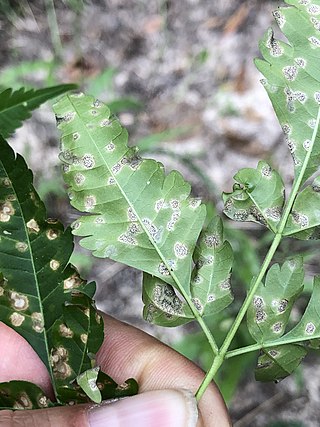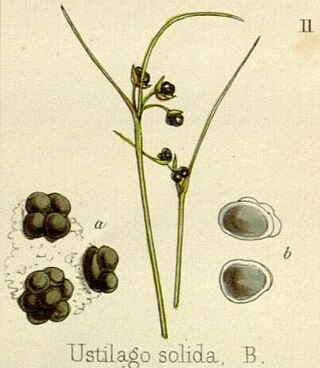Blight is a specific symptom affecting plants in response to infection by a pathogenic organism.

Hevea brasiliensis, the Pará rubber tree, sharinga tree, seringueira, or most commonly, rubber tree or rubber plant, is a flowering plant belonging to the spurge family, Euphorbiaceae, originally native to the Amazon basin, but is now pantropical in distribution due to introductions. It is the most economically important member of the genus Hevea because the milky latex extracted from the tree is the primary source of natural rubber.
Spegazzinia is a genus of widely distributed mitosporic ascomycete fungi in the family Didymosphaeriaceae.As accepted by Wijayawardene et al. 2020.

Cercospora is a genus of ascomycete fungi. Most species have no known sexual stage, and when the sexual stage is identified, it is in the genus Mycosphaerella. Most species of this genus cause plant diseases, and form leaf spots. It is a relatively well-studied genus of fungi, but there are countless species not yet described, and there is still much to learn about the best-known members of the genus.

Pseudocercospora subsessilis is a fungal plant pathogen infecting chinaberry tree. It is widespread in tropical and subtropical areas on host species of the genera Azadirachta and Swietenia.

Eudarluca is a genus of fungi in the family Phaeosphaeriaceae. The genus was circumscribed by Italian-born Argentinian botanist and mycologist Carlo Luigi Spegazzini in 1908, with Eudarluca australis assigned as the type species.
Ophiosphaerella is a genus of fungi in the family Phaeosphaeriaceae. The genus was described by Italian-Argentinian botanist and mycologist Carlos Luigi Spegazzini in 1909.
Alternaria penicillata is a species of fungi in the family Pleosporaceae, which causes leaf blight of opium poppy. The fungus is found in Europe, Australia, India, Japan, Nepal, Pakistan, South Africa, Turkey, USA and Zambia.
Bertiella is a genus of fungi in the family Teichosporaceae. although Wijayawardene et al. 2020 places it within the Melanommataceae family.
Griphosphaerioma is a genus of fungi in the family Amphisphaeriaceae. It is also in the Subclass Xylariomycetidae O.E. Erikss & Winka and order Amphisphaeriales D. Hawksw. & O.E. Erikss.
Schistophoron is a genus of lichenized fungi in the family Graphidaceae. It contains 5 species.

Asterina is a large genus of fungi in the Asterinaceae family. It was then placed in Asterinales order later. The genus was circumscribed by French mycologist Joseph-Henri Léveillé in 1845.

Aecidium is a genus of rust fungi in the order Pucciniales.

Camarosporium is a genus of fungi belonging to the order Pleosporales, and originally placed in family Coniothyriaceae. It was then placed in the family Camarosporiaceae Wanas., Wijayaw., K.D. Hyde & Crous, 2017 with another genus Camarosporomyces. This has been accepted by Wijayawardene et al. 2020.

Cintractia is a genus of fungi belonging to the family Anthracoideaceae. It was first described by Marie Maxime Cornu in 1883.
Dilophospora is a genus of fungi belonging to the order Dothideomycetes, in the family Sporocadaceae.
Lichenoverruculina is a fungal genus in the family Hyponectriaceae and order Amphisphaeriales. This is a monotypic genus, containing the single species Lichenoverruculina sigmatospora. which was published in Herzogia vol.24 (2) on page 274 in 2011.
Heterotruncatella is a genus of plant pathogens in the family Sporocadaceae.

Neocamarosporium is a genus of ascomycete fungi, as accepted by Wijayawardene et al. 2020. The species are typically halotolerant, being commonly found in saline environments like in saline water, hypersaline soils and especially in association with halophytes.
The Sphaeropsis are a genus of fungi, within the family of Botryosphaeriaceae and within the order of Botryosphaeriales, within the class Dothideomycetes. They are plant pathogens.









